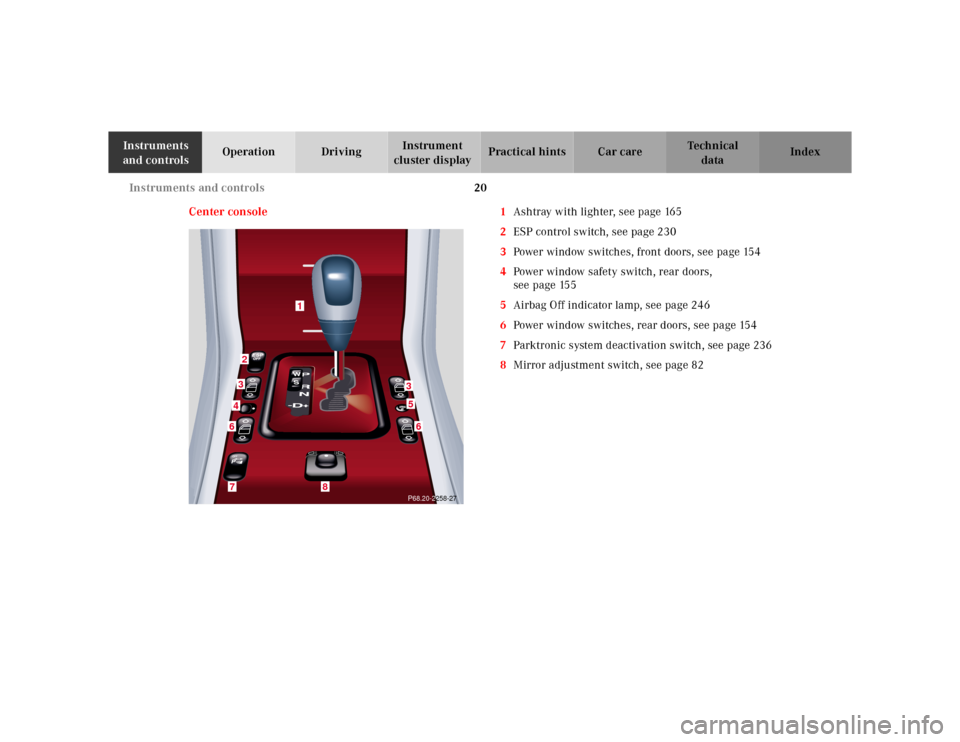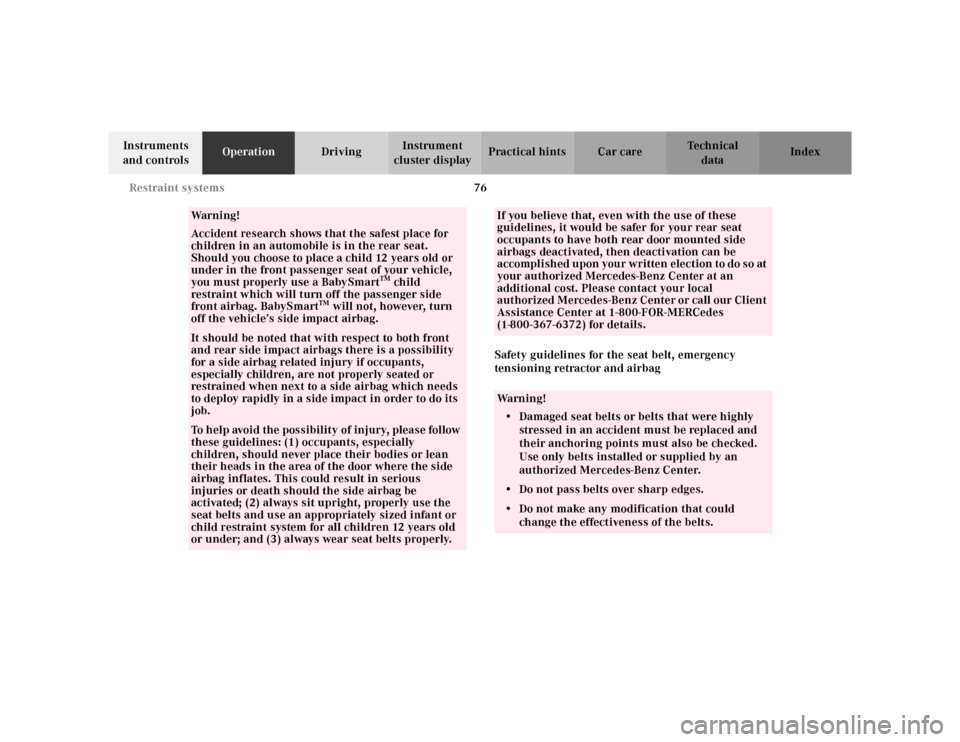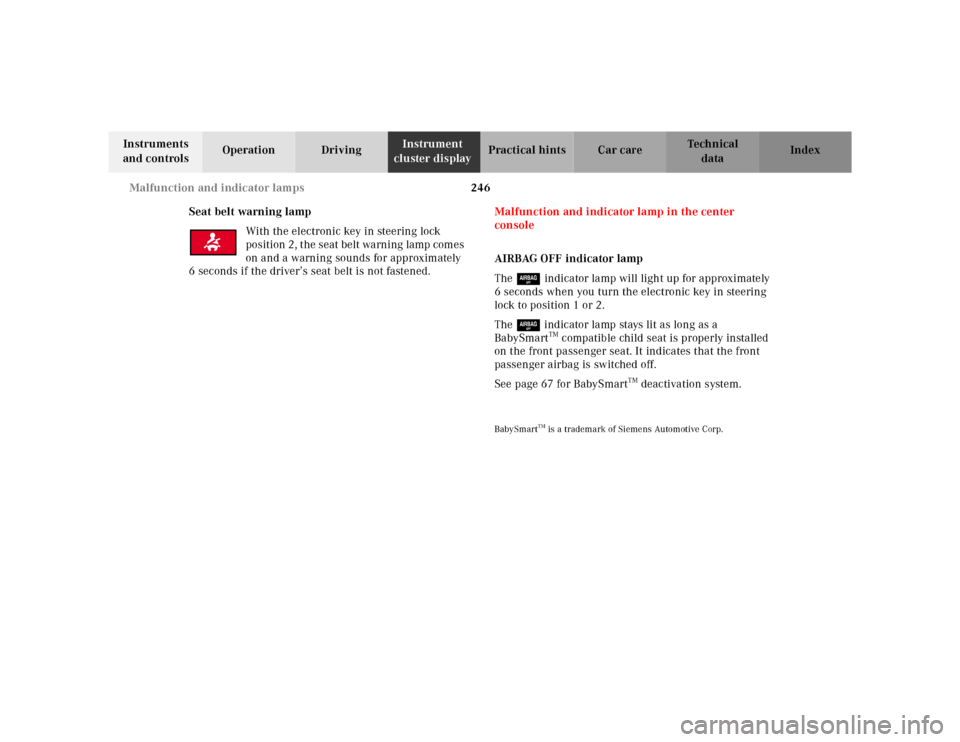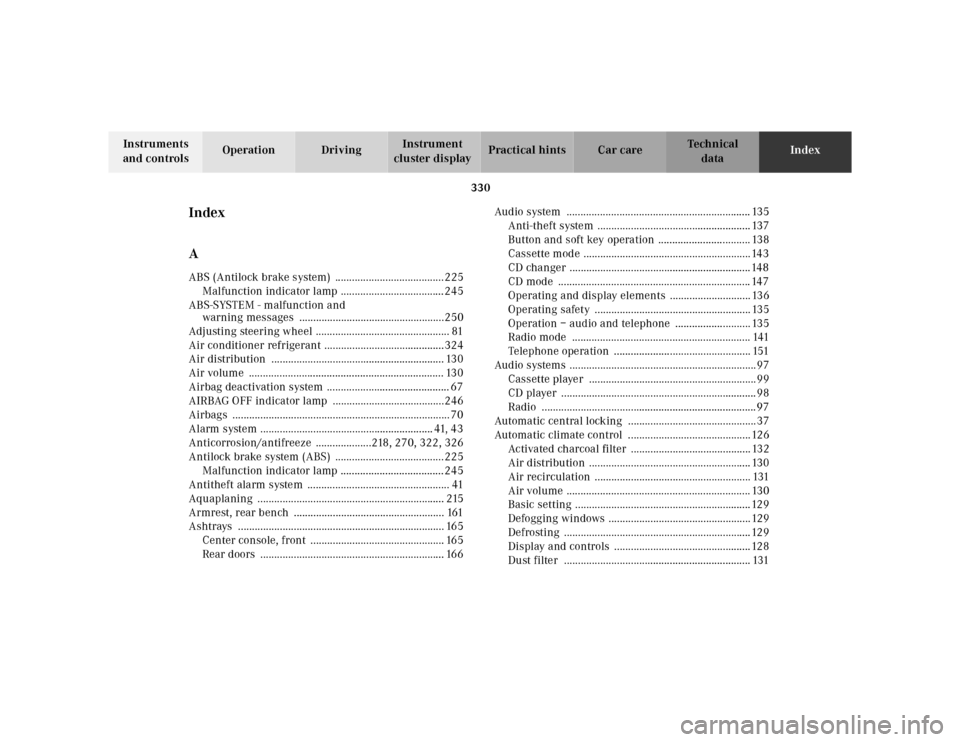2001 MERCEDES-BENZ E-Class WAGON airbag off
[x] Cancel search: airbag offPage 7 of 345

4 Contents
AIRBAG OFF
indicator lamp .............................246
Malfunction and warning
messages in the
multifunction display ............... 247
DISPLAY DEFECTIVE ................248
BATTERY / ALTERNATOR .........249
ABS-SYSTEM ...............................250
BRAKE ASSIST ...........................250
BRAKE LINING WEAR .............. 251
BRAKE FLUID ............................. 251
PARKING BRAKE .......................252
ENGINE FAN ...............................252
COOLANT (coolant level) ..........253
COOLANT TEMP. (coolant
temperature) ...............................254
LIGHTING SYSTEM ....................255
LIGHT SENSOR ...........................256
REMOVE KEY .............................256
TELE AID .....................................257
STEERING GEAR OIL .................257
ENGINE OIL LEVEL ...................258
WASHER FLUID ..........................259ELEC. STABIL. PROG.
(Electronic stability program) . 260
Practical hintsFirst aid kit ..................................... 262
Fuses ............................................... 263
Electrical outlet.............................. 265
Hood ................................................ 266
Checking engine oil level............. 268
Automatic transmission
fluid level ................................... 269
Coolant level................................... 269
Adding coolant ........................... 270
Windshield and headlamp
washer system .......................... 271
Windshield and headlamp
washer fluid mixing ratio .........271
Spare wheel, vehicle tools............ 272
Vehicle jack .................................... 273
Wheels ............................................ 274
Tire replacement ........................274
Rotating wheels ......................... 275
Spare wheel..................................... 276
Spare wheel bolts .......................276Changing wheels ........................... 277
Tire inflation pressure .................. 282
Battery ............................................. 283
Jump starting .................................. 285
Towing the vehicle ......................... 288
Transmission selector lever,
manually unlocking .................. 290
Exterior lamps ................................ 291
Headlamp assembly ...................292
Taillamp assemblies ..................295
Changing batteries in the
electronic main key .................. 298
Synchronizing
remote control ............................300
Emergency engine
shut-down................................... 300
Emergency operation of
sliding / pop-up roof ................. 301
Manual release for
fuel filler flap ............................. 302
Replacing wiper blade insert ....... 302
Roof rack ......................................... 305
Page 23 of 345

20 Instruments and controls
Te ch n ica l
data Instruments
and controlsOperation DrivingInstrument
cluster displayPractical hints Car care Index
Center console 1Ashtray with lighter, see page 165
2ESP control switch, see page 230
3Power window switches, front doors, see page 154
4Power window safety switch, rear doors,
seepage155
5Airbag Off indicator lamp, see page 246
6Power window switches, rear doors, see page 154
7Parktronic system deactivation switch, see page 236
8Mirror adjustment switch, see page 82
356
6432
1
7
8
P68.20-2258-27
Page 67 of 345

64 Restraint systems
Te ch n ica l
data Instruments
and controlsOperationDrivingInstrument
cluster displayPractical hints Car care Index
Unfastening of seat belts
Push the release button (3) in the belt buckle (2).
Allow the retractor to completely rewind the seat belt by
guiding the latch plate (1).
Wa r n i n g !
USE SEAT BELTS PROPERLY.• Seat belts can only work when used properly.
Never wear seat belts in any other way than as
described in this section, as that could result
in serious injuries in case of an accident.• Each occupant should wear their seat belt at all
times, because seat belts help reduce the
likelihood of and potential severity of injuries
in accidents, including rollovers. The
integrated restraint system includes “SRS”
(driver airbag, front passenger airbag, front
and rear door mounted side impact airbags,
head protection window curtain airbags for
side windows), “ETR” (seat belt emergency
tensioning retractors), and front seat knee
bolsters. The system is designed to enhance the
protection offered to properly belted occupants
in certain frontal (front airbags) and side (side
impact and window curtain airbags) impacts
which exceed preset deployment thresholds.
Page 79 of 345

76 Restraint systems
Te ch n ica l
data Instruments
and controlsOperationDrivingInstrument
cluster displayPractical hints Car care Index
Safety guidelines for the seat belt, emergency
tensioning retractor and airbag
Wa r n i n g !
Accident research shows that the safest place for
children in an automobile is in the rear seat.
Should you choose to place a child 12 years old or
under in the front passenger seat of your vehicle,
you must properly use a BabySmart
TM child
restraint which will turn off the passenger side
front airbag. BabySmart
TM will not, however, turn
off the vehicle’s side impact airbag.
It should be noted that with respect to both front
and rear side impact airbags there is a possibility
for a side airbag related injury if occupants,
especially children, are not properly seated or
restrained when next to a side airbag which needs
to deploy rapidly in a side impact in order to do its
job.To help avoid the possibility of injury, please follow
these guidelines: (1) occupants, especially
children, should never place their bodies or lean
their heads in the area of the door where the side
airbag inflates. This could result in serious
injuries or death should the side airbag be
activated; (2) always sit upright, properly use the
seat belts and use an appropriately sized infant or
child restraint system for all children 12 years old
or under; and (3) always wear seat belts properly.
If you believe that, even with the use of these
guidelines, it would be safer for your rear seat
occupants to have both rear door mounted side
airbags deactivated, then deactivation can be
accomplished upon your written election to do so at
your authorized Mercedes-Benz Center at an
additional cost. Please contact your local
authorized Mercedes-Benz Center or call our Client
Assistance Center at 1-800-FOR-MERCedes
(1-800-367-6372) for details.Wa r n i n g !
• Damaged seat belts or belts that were highly
stressed in an accident must be replaced and
their anchoring points must also be checked.
Use only belts installed or supplied by an
authorized Mercedes-Benz Center.• Do not pass belts over sharp edges.• Do not make any modification that could
change the effectiveness of the belts.
Page 91 of 345

88 Instrument cluster
Te ch n ica l
data Instruments
and controlsOperationDrivingInstrument
cluster displayPractical hints Car care Index
Indicator lamps in the instrument cluster
High beam
ABS malfunction, see page 245
Brake fluid low (except Canada).
Parking brake engaged, see page 243
Brake fluid low (Canada only).
Parking brake engaged, see page 243
BAS malfunction, see page 245
ESP malfunction, see page 245
Fasten seat belts, see page 246
ESP. Adjust driving to road condition,
see page 245Engine malfunction indicator lamp. If the
“CHECK ENGINE” malfunction indicator
lamp comes on when the engine is running,
it indicates a malfunction of the fuel
management system, emission control
system, systems which impact emissions, or
the fuel cap is not closed tight. In all cases,
we recommend that you have the
malfunction checked as soon as possible,
see page 242
SRS malfunction, see page 244
Function indicator lamp on the center console
Front passenger airbag automatically
switched off, see page 246
ABSBRAKE
CHECK
ENGINESRS
Page 244 of 345

241 Contents - Instrument cluster display
Te ch n ica l
data Instruments
and controlsOperation DrivingInstrument
cluster displayPractical hints Car care Index
Instrument cluster displayMalfunction and indicator
lamps in the
instrument cluster .................... 242
On-board
diagnostic system .......................242
Check engine malfunction
indicator lamp .............................242
Brake warning lamp ..................243
Supplemental restraint
system (SRS)
indicator lamp .............................244
Fuel reserve and fuel cap
placement warning ....................244
Electronic stability program
(ESP) — warning lamp ...............245BAS / ESP malfunction
indicator lamp ............................ 245
ABS malfunction
indicator lamp ............................ 245
Seat belt warning lamp ............. 246
Malfunction and
indicator lamp in the
center console ........................... 246
AIRBAG OFF
indicator lamp ............................ 246
Malfunction and warning
messages in the
multifunction display .............. 247
DISPLAY DEFECTIVE ................ 248
BATTERY / ALTERNATOR ........ 249
ABS-SYSTEM .............................. 250
BRAKE ASSIST ........................... 250
BRAKE LINING WEAR .............. 251BRAKE FLUID ............................. 251
PARKING BRAKE .......................252
ENGINE FAN ...............................252
COOLANT
(coolant level) .............................253
COOLANT TEMP.
(coolant temperature) ................254
LIGHTING SYSTEM ....................255
LIGHT SENSOR ...........................256
REMOVE KEY .............................256
TELE AID .....................................257
STEERING GEAR OIL .................257
ENGINE OIL LEVEL ...................258
WASHER FLUID .........................259
ELEC. STABIL. PROG.
(Electronic stability
program) ......................................260
Page 249 of 345

246 Malfunction and indicator lamps
Te ch n ica l
data Instruments
and controlsOperation DrivingInstrument
cluster displayPractical hints Car care Index
Seat belt warning lamp
With the electronic key in steering lock
position 2, t he seat belt wa rning lamp com es
on and a warning sounds for approximately
6 seconds if the driver’s seat belt is not fastened.Malfunction and indicator lamp in the center
console
AIRBAG OFF indicator lamp
The 7 indicator lamp will light up for approximately
6 seconds when you turn the electronic key in steering
lock to position 1 or 2.
The 7 indicator lamp stays lit as long as a
BabySmart
TM compatible child seat is properly installed
on the front passenger seat. It indicates that the front
passenger airbag is switched off.
See page 67 for BabySmart
TM deactivation system.
BabySmart
TM is a trademark of Siemens Automotive Corp.
Page 333 of 345

330
Te ch n ica l
data Instruments
and controlsOperation DrivingInstrument
cluster displayPractical hints Car careIndex
Index
AABS (Antilock brake system) .......................................225
Malfunction indicator lamp .....................................245
ABS-SYSTEM - malfunction and
warning messages ....................................................250
Adjusting steering wheel ................................................ 81
Air conditioner refrigerant ...........................................324
Air distribution .............................................................. 130
Air volume ...................................................................... 130
Airbag deactivation system ............................................ 67
AIRBAG OFF indicator lamp ........................................246
Airbags .............................................................................. 70
Alarm system .............................................................. 41, 43
Anticorrosion/antifreeze ....................218, 270, 322, 326
Antilock brake system (ABS) .......................................225
Malfunction indicator lamp .....................................245
Antitheft alarm system ................................................... 41
Aquaplaning ................................................................... 215
Armrest, rear bench ...................................................... 161
Ashtrays .......................................................................... 165
Center console, front ................................................ 165
Rear doors .................................................................. 166Audio system .................................................................. 135
Anti-theft system ....................................................... 137
Button and soft key operation ................................. 138
Cassette mode ............................................................143
CD changer .................................................................148
CD mode ..................................................................... 147
Operating and display elements ............................. 136
Operating safety ........................................................ 135
Operation – audio and telephone ........................... 135
Radio mode ................................................................ 141
Telephone operation ................................................. 151
Audio systems ...................................................................97
Cassette player ............................................................99
CD player ......................................................................98
Radio .............................................................................97
Automatic central locking ..............................................37
Automatic climate control ............................................126
Activated charcoal filter ........................................... 132
Air distribution .......................................................... 130
Air recirculation ........................................................ 131
Air volume .................................................................. 130
Basic setting ...............................................................129
Defogging windows ...................................................129
Defrosting ...................................................................129
Display and controls .................................................128
Dust filter ................................................................... 131